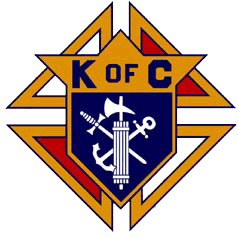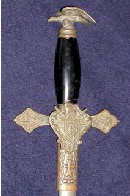



|
|
The Fourth Degree is the highest degree of the order. Members of this degree are addressed as "Sir Knight". The primary purpose of the Fourth Degree is to foster the spirit of patriotism and to encourage active Catholic citizenship. Fewer than 18% of Knights join the Fourth Degree, which is optional; of a total 1,703,307 Knights there were 292,289 Fourth Degree Knights. A Knight is eligible to join the Fourth Degree after six months from the date of his First Degree, providing he has completed the 2nd and 3rd degrees beforehand.
On February 22,
1900, the first Fourth Degree exemplification or degree ceremony was held in
New York City. The Fourth Degree imparts a lesson on the virtue of
patriotism. The primary purpose of this degree is to foster the spirit of
patriotism in members and the community at large and encourage active
Catholic citizenship. Today there are some 300,000 Fourth Degree Knights out
of the total 1.6 million member Knights of Columbus.
The Color Corps of the Patriotic DegreeW hen knighthood was in flower, knights carried the sword to defend their God, their Church, their country and their fellow man according to the code of chivalry. Today, Sir Knights wear regalia and carry the sword to honor Christ and His apostles, especially on religious and civic occasions specified in this manual. Hence, the primary purpose of the Fourth Degree is to encourage active Catholic citizenship and foster the spirit of patriotism in members and the community at large.The Color Corps members exemplify all the principles of our Order:
The public appearance of Fourth Degree Knights as a Color Corps at religious and civic functions is an important activity of each assembly. Their colorful capes and chapeaux add dignity and the pride of Church and country to any event. By these public demonstrations their loyalties bring credit to themselves and to the Knights of Columbus.
The Memorial ChaliceO ne of the time-honored traditions of the Fourth Degree of the Knights of Columbus is the Memorial Chalice and Chalice Ceremony. When a Fourth Degree member in good standing passes away, a chalice is donated in his memory to the religious order or organization of his choosing. The beautiful Chalice Ceremony is conducted as part of the deceased Sir Knight's wake or funeral vigil. A chalice, engraved with the Sir Knight's name, is presented to the family, used in the memorial Mass, and then
delivered to the
recipient by representatives of the assembly according to the Sir Knight's
wishes.
name, is presented to the family, used in the memorial Mass, and then
delivered to the
recipient by representatives of the assembly according to the Sir Knight's
wishes.
The sacred vessels consist of a gold chalice and a gold paten. A Satin cloth with emblem and gold trim is used to display the chalice and paten during the Chalice Ceremony.
The history of the creation of the Fourth Degree of the Knights of Columbus of is directly linked to the social and political climate in the United States at the turn of the last century. It is in that light that the connection between the Fourth Degree and its Color Corps, that has grown to be the most visible aspect of the Knights, must be seen. The idea of adding new degrees to the Order's original three, (Charity, Unity, Fraternity) first came to light in 1886. Supreme Knight James T. Mullen appointed a committee to look into forming two new "commander" degrees. That same year the Connecticut Catholic, a local newspaper, carried an advertisement calling members of local Knights of Columbus councils to meet to form a "Uniformed Legion." The idea for this new unit arose from a growing nation wide sense of Nationalism, or what we would call today Patriotism. The unknown author in Connecticut was not alone in wanting a visible organization. Little happened at this time because there was not enough wide spread interest in creating additional new degrees. The Order's leaders balked at the idea of a Uniformed Legion for the simple reason that the cost for the "Uniform" was well over $100.00. They feared the "Legion" would cause an economical class split between wealthy and poorer members of the Order. Following the Spanish American War, it was decided that there should be one new Degree added based on the principle of Patriotism. In 1899, Edward L. Hearn was elected Supreme Knight and he immediately appointed a committee to establish and format the new Degree to be given the following year. In order to qualify for this Degree each candidate had to be a Third Degree member of the Knights of Columbus in good standing for three years, and show evidence of distinctive service to the Order, church, and community. Finally the candidate had to have a letter from his priest stipulating that he had received communion within the past two weeks. The first Exemplification of the new Degree was scheduled to be held in the Astor Hotel in New York City on February 22, 1900. However, there were so many candidates, the Exemplification had to be moved to a larger venue. Therefore the site was moved to the Lenox Lyceum. At this first Exemplification of the Fourth Degree 1,100 members of the Knights of Columbus, being in good standing "took their fourth." The second Exemplification, held in Boston on May 8, 1900 saw another 750 Third Degree knights join the ranks of Sir Knights. In the early years of the Fourth Degree, members met as part of their councils, mostly after meetings. In 1910, during a reorganization of the Order's leadership, the first Assemblies were created. Additionally the position of Supreme Master was established to lead the Fourth Degree internationally. Vice Supreme Masters lead Provinces and Masters head Districts. This system has spread and flourished as Sir Knights not only serve their local Church through their service to local councils but also their joint efforts in these Assemblies. The Honor Guard, first called for in 1886 was officially formed in 1902, for ceremonial purposes. Since that time, the uniforms of the Color Corps have varied, however all have shared the similar theme of mariners. Most noticeable in today's current uniform is the chapeau worn with ostrich feathers. The first Fourth Degree exemplification held in Canada was in Montreal Quebec July 14, 1907 In the year 2000, the Fourth degree celebrated its 100th anniversary with approximately 252,000 member Sir Knights!!!
In 1900, Patriotism is added as the fourth principle of the Order. The 1st Exemplification  of the Fourth Degree took place on February 2, 1900 at
the Astor Hotel in of the Fourth Degree took place on February 2, 1900 at
the Astor Hotel in The 2nd Exemplification of the Fourth Degree took place on May 8th in Since that First Exemplification in 1900, there have been three major styles of swords with black grip. The first major type of sword had a Flying Eagle on the pommel (grip cap) and the Emblem of the Order on the Guard. This type of sword was made until at least the early 1930's . The sword blade was usually 28 inches in length with the overall length in the scabbard being 37 inches. You may click on any sword to see a larger more detailed picture.
The other change that was made is that the Triad Emblem of the Fourth
Degree replaces the Emblem of the Order on the Guard. This type of sword
appears to have been made through the late 1940's early 50's. These swords
over the years seem to vary in length. The blades ranged between 26 and 27
1/2 inches with the sword grip and pommel adding another 6 inches. When in
the scabbard they were between 35 and 37 inches in length. Most, if not all,
of this type of sword were made by T.C. Gleason in
The English Company and Lynch & Kelly are the two primary manufacturers
of swords in the
Again over the last 40 years the blade, sword, and total
length have varied as with the second type of sword. Finally, the blades
have varied in style as well. Sometime the blades are plain and others
contain etching on the blade. Usually, the etching says Knights of Columbus
on one
There are two other types of swords that you may see.
Both of them have a white grip. The first is the same metal color as the
swords with the black grip. The white grip indicates that the sword belonged
to a Faithful Navigator and can be worn by either a current Faithful
Navigator or Past Faithful Navigator.
The final type is a white grip sword, but plated in gold. This sword is worn by current and former Masters, Vice-Supreme Masters, Supreme Masters.
Sword Archive
|
The 4th Degree Triad
Your invited! Join the Fourth Degree
Full Manual
1890
1910
|
In service to one....
![]() In service to all.
In service to all.
© Copyright 2010-2013 Knights of Columbus
Port Hope Council #6490